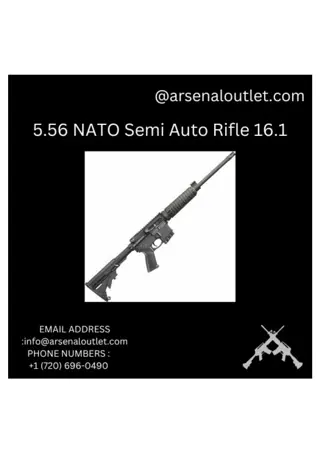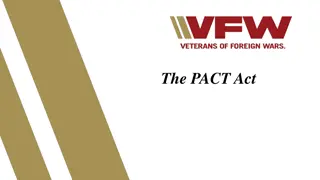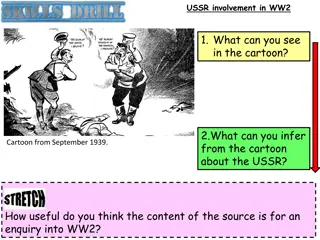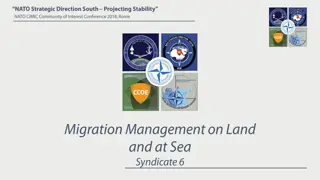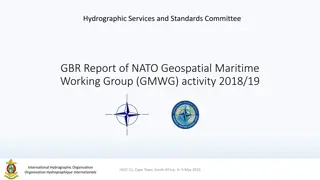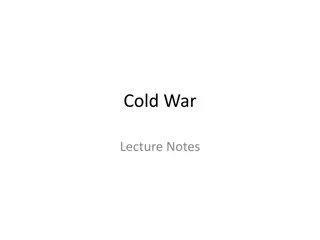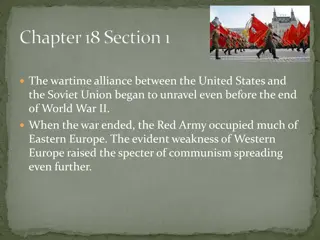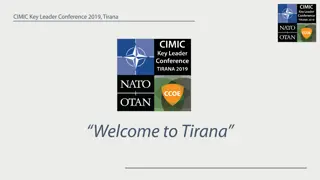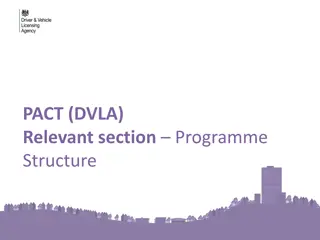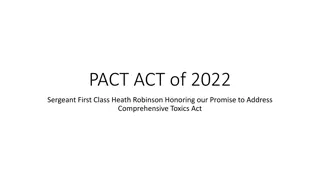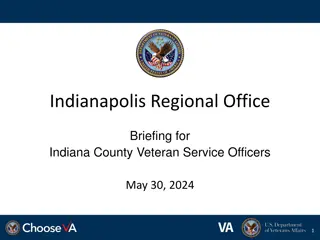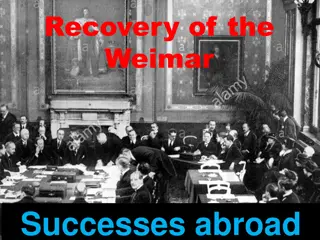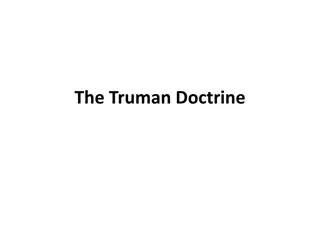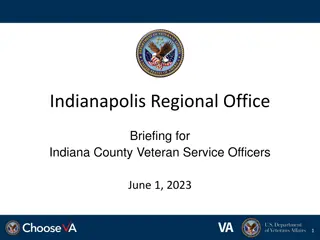
Cold War Alliances: NATO, Warsaw Pact, and Arms Race
Explore the historical context of NATO, the Warsaw Pact, and the Arms Race during the Cold War era. Understand the motivations behind the creation of these military alliances and their impact on global geopolitics.
Download Presentation

Please find below an Image/Link to download the presentation.
The content on the website is provided AS IS for your information and personal use only. It may not be sold, licensed, or shared on other websites without obtaining consent from the author. If you encounter any issues during the download, it is possible that the publisher has removed the file from their server.
You are allowed to download the files provided on this website for personal or commercial use, subject to the condition that they are used lawfully. All files are the property of their respective owners.
The content on the website is provided AS IS for your information and personal use only. It may not be sold, licensed, or shared on other websites without obtaining consent from the author.
E N D
Presentation Transcript
AGENDA Survey (15 mins) Survey (15 mins) Finish Civil Defense Poster (30 mins) Finish Civil Defense Poster (30 mins) Share out of poster (10 mins) Share out of poster (10 mins) NATO and Warsaw Pact PowerPoint (15 mins) NATO and Warsaw Pact PowerPoint (15 mins) Making A Pact Activity (20 mins) Making A Pact Activity (20 mins)
The USA used nuclear war fear to set up an alliance to defend the Western world. It was called the North Atlantic Treaty North Atlantic Treaty Organization Organization (NATO NATO), and countries signed up in April 1949. 12 countries originally signed the treaty. US officials called NATO an antidote to fear . US officials called NATO an antidote to fear . How do you think the USSR perceived it? How do you think the USSR perceived it?
Impact on the Arms Race The USA and the USSR competed to build more and more powerful weapons. This was called the Arms Race Arms Race, and it is closely linked to NATO and the Warsaw Pact. Each side tried to become more powerful than the other. The USA claimed NATO was a defensive alliance against the USSR. However, when NATO was first set up, the USA had a nuclear monopoly on the world. The USSR did not even test nuclear weapons until later that year. By then, the USA was working on even more powerful versions! Why do you think the USA really was so keen on NATO? Why do you think the USA really was so keen on NATO?
The reaction of the USSR In May 1955, West Germany was admitted into NATO. Worst fears realized Germany being rebuilt and now part of a military alliance! How do you think the USSR felt about this? Action is needed what can the USSR do to counter NATO? What was the real purpose of NATO? Could it be offensive?
Creation of the Warsaw Pact West Germany joining NATO now meant that Germany once again had military power. For the Soviets, who had suffered greatly at the hands of the Germans, this was too much. The Soviets set up the Warsaw Pact Warsaw Pact which the Eastern European countries signed. It was intended to be a defensive alliance, like NATO, but it was essentially used to keep control in Eastern Europe. Why do you think the USSR set up the Warsaw Pact? Why do you think the USSR set up the Warsaw Pact?
Why was the Warsaw Pact created? Match the reasons and the explanations.
Why was the Warsaw Pact created? Now put the reasons in order of importance.
Membership of NATO and the Warsaw Pact right_button
Which was the stronger organization? NATO NATO Warsaw Pact Warsaw Pact NATO had territory separated by water and land (non-NATO countries e.g. Switzerland). NATO was a voluntary alliance of democratic states. USA was a major part of NATO, but each member was involved in decision making. NATO had overall military superiority. Moscow had political domination over central and Eastern Europe. The Warsaw Pact countries had geographic cohesion (was one large area) and land connections, so it was easy to transfer forces and weapons. The Warsaw Pact very clearly controlled from Moscow. Which organization do you think has greater power? Why? Which organization do you think has greater power? Why?
In groups list at least FOUR (4) things alliances would do for each other. In groups list at least FOUR (4) things alliances would do for each other. In each box EXPLAIN WHY those four things are important for In each box EXPLAIN WHY those four things are important for allied countries allied countries
A comparison of the two treaties the Parties will maintain and develop their individual and collective capacity to resist armed attack. the best way to ensure peace and prevent new aggression is the organization of a system of collective security new measures [are required] for strengthening the defences of our peace-loving countries. The treaty of friendship, co-operation and mutual aid is precisely to serve these aims. The Parties agree that an armed attack against one of them shall be considered an attack against them all. From the NATO Treaty, 1949. From the NATO Treaty, 1949. From the Warsaw Pact, 1955. From the Warsaw Pact, 1955. What do the two treaties have in common? What do the two treaties have in common? Is one more aggressive than the other? Is one more aggressive than the other? Which treaty suggests more control? Why? Which treaty suggests more control? Why? right_button



